Integrating Vertical Farming into Residential Buildings in Egypt: A Stakeholder Perspectives-Based Approach
Abstract
1. Introduction
2. Literature
3. Case Study
4. Method
4.1. Data Collection Method
4.2. Sampling
4.3. Data Analysis Method
4.4. Time Horizon
4.5. Study Limitations
5. Results of Experts’ Survey
6. Results of Users’ Survey
7. Discussion
8. Conclusions
Author Contributions
Funding
Data Availability Statement
Acknowledgments
Conflicts of Interest
References
- United Nations. Food. Available online: https://www.un.org/en/global-issues/food (accessed on 16 February 2024).
- Food and Agriculture Organization of the United Nations. The State of Food Security and Nutrition in the World 2023. Urbanization, Agrifood Systems Transformation and Healthy Diets Across the Rural–Urban Continuum. Available online: https://www.fao.org/3/CC3017EN/online/CC3017EN.html (accessed on 16 February 2024).
- United Nations, UN DESA|United Nations Department of Economic and Social Affairs. Available online: https://www.un.org/development/desa/en/news/population/2018-revision-of-world-urbanization-prospects.html (accessed on 13 May 2022).
- Benis, K.; Reinhart, C.; Ferrão, P. Development of a simulation-based decision support workflow for the implementation of Building-Integrated Agriculture (BIA) in urban contexts. J. Clean. Prod. 2017, 147, 589–602. [Google Scholar] [CrossRef]
- Orsini, F.; Kahane, R.; Nono-Womdim, R.; Gianquinto, G. Urban agriculture in the developing world: A review. Agron. Sustain. Dev. 2013, 33, 695–720. [Google Scholar] [CrossRef]
- Pons, O.; Nadal, A.; Sanyé-Mengual, E.; Llorach-Massana, P.; Cuerva, E.; Sanjuan-Delmàs, D.; Muñoz, P.; Oliver-Solà, J.; Planas, C.; Rovira, M.R. Roofs of the future: Rooftop greenhouses to improve buildings metabolism. Procedia Eng. 2015, 123, 441–448. [Google Scholar] [CrossRef]
- Appolloni, E.; Orsini, F.; Specht, K.; Thomaier, S.; Sanyé-Mengual, E.; Pennisi, G.; Gianquinto, G. The global rise of urban rooftop agriculture: A review of worldwide cases. J. Clean. Prod. 2021, 296, 126556. [Google Scholar] [CrossRef]
- Tablada, A.; Kosorić, V.; Huang, H.; Chaplin, I.K.; Lau, S.-K.; Yuan, C.; Lau, S.S.-Y. Design optimization of productive façades: Integrating photovoltaic and farming systems at the tropical technologies laboratory. Sustainability 2018, 10, 3762. [Google Scholar] [CrossRef]
- Tablada, A.; Kosorić, V. Vertical farming on facades: Transforming building skins for urban food security. In Rethinking Building Skins; Woodhead Publishing: Cambridge, UK, 2022. [Google Scholar] [CrossRef]
- Shahda, M.; Megahed, N. Post-pandemic architecture: A critical review of the expected feasibility of skyscraper-integrated vertical farming (SIVF). Archit. Eng. Des. Manag. 2023, 19, 283–304. [Google Scholar] [CrossRef]
- Safikhani, T.; Abdullah, A.M.; Ossen, D.R.; Baharvand, M. A review of energy characteristic of vertical greenery systems. Renew. Sustain. Energy Rev. 2014, 40, 450–462. [Google Scholar] [CrossRef]
- Bustami, R.A.; Belusko, M.; Ward, J.; Beecham, S. Vertical Greenery Systems: A Systematic Review of Research Trends; Elsevier Ltd.: Amsterdam, The Netherlands, 2018. [Google Scholar] [CrossRef]
- Wang, Y.; Zhang, X.; Zhang, Y.; Zhang, H.; Xiong, B.; Shi, X. Multi-Objective Analysis of Visual, Thermal, and Energy Performance in Coordination with the Outdoor Thermal Environment of Productive Façades of Residential Communities in Guangzhou, China. Buildings 2023, 13, 1540. [Google Scholar] [CrossRef]
- Nadal, A.; Alamús, R.; Pipia, L.; Ruiz, A.; Corbera, J.; Cuerva, E.; Rieradevall, J.; Josa, A. Urban planning and agriculture. Methodology for assessing rooftop greenhouse potential of non-residential areas using airborne sensors. Sci. Total Environ. 2017, 601–602, 493–507. [Google Scholar] [CrossRef]
- Gamal, A.; Eleinen, O.A.; Eltarabily, S.; Elgheznawy, D. Enhancing urban resilience in hot humid climates: A conceptual framework for exploring the environmental performance of vertical greening systems (VGS). Front. Arch. Res. 2023, 12, 1260–1284. [Google Scholar] [CrossRef]
- Zhong, W.; Schroeder, T.; Bekkering, J. Designing with nature: Advancing three-dimensional green spaces in architecture through frameworks for biophilic design and sustainability. Front. Arch. Res. 2023, 12, 732–753. [Google Scholar] [CrossRef]
- Al-Kodmany, K. The vertical farm: A review of developments and implications for the vertical city. Buildings 2018, 8, 24. [Google Scholar] [CrossRef]
- Souza, E. Creating Vertical Gardens and Green Facades with Steel Cables|ArchDaily. ArchDaily. Available online: https://www.archdaily.com/933692/creating-vertical-gardens-and-green-facades-with-steel-cables (accessed on 19 February 2024).
- Porada, B. London’s Largest ‘Living Wall’/Gary Grant|ArchDaily. ArchDaily. Available online: https://www.archdaily.com/423990/largest-living-wall-unveiled-in-london (accessed on 19 February 2024).
- Harrouk, C. Koichi Takada Unveils World’s Most Dense Vertical Gardens, for a Mixed-Use Highrise in Brisbane, Australia|ArchDaily. ArchDaily. Available online: https://www.archdaily.com/947214/koichi-takada-unveils-worlds-most-dense-vertical-gardens-for-a-mixed-use-highrise-in-brisbane-australia (accessed on 19 February 2024).
- Abdel, H. SkyGarden House/Pham Huu Son Architects|ArchDaily. ArchDaily. Available online: https://www.archdaily.com/1011892/skygarden-house-pham-huu-son-architects (accessed on 19 February 2024).
- Allen, K. In Tokyo, a Vertical Farm Inside and Out|ArchDaily. ArchDaily. Available online: https://www.archdaily.com/428868/in-tokyo-a-vertical-farm-inside-and-out (accessed on 19 February 2024).
- Saad, M.H.M.; Hamdan, N.M.; Sarker, M.R. State of the art of urban smart vertical farming automation system: Advanced topologies, issues and recommendations. Electronics 2021, 10, 1422. [Google Scholar] [CrossRef]
- Kalantari, F.; Tahir, O.M.; Lahijani, A.M.; Kalantari, S. A Review of Vertical Farming Technology: A Guide for Implementation of Building Integrated Agriculture in Cities. Adv. Eng. Forum 2017, 24, 76–91. [Google Scholar] [CrossRef]
- Shahda, M.M. Vertical Farming: A Catalyst for Integrating Biophilic Design into Built Environment. J. Sustain. Arch. Civ. Eng. 2025, 37, 140–157. [Google Scholar] [CrossRef]
- Kosorić, V.; Huang, H.; Tablada, A.; Lau, S.K.; Tan, H.T.W. Survey on the social acceptance of the productive façade concept integrating photovoltaic and farming systems in high-rise public housing blocks in Singapore. Renew. Sustain. Energy Rev. 2019, 111, 197–214. [Google Scholar] [CrossRef]
- Sandison, F.; Yeluripati, J.; Stewart, D. Does green vertical farming offer a sustainable alternative to conventional methods of production?: A case study from Scotland. Food Energy Secur. 2022, 12, e438. [Google Scholar] [CrossRef]
- Banerjee, C.; Adenaeuer, L. Up, Up and Away! The Economics of Vertical Farming. J. Agric. Stud. 2013, 2, 40. [Google Scholar] [CrossRef]
- Kalantari, F.; Tahir, O.M.; Joni, R.A.; Fatemi, E. Opportunities and challenges in sustainability of vertical farming: A review. J. Landsc. Ecol. 2018, 11, 35–60. [Google Scholar] [CrossRef]
- Despommier, D. The Vertical Farm: Feeding the World in the 21st Century; Macmillan: New York, NY, USA, 2010. [Google Scholar]
- Waldron, D. Evolution of vertical farms and the development of a simulation methodology. WIT Trans. Ecol. Environ. 2018, 217, 975–986. [Google Scholar] [CrossRef]
- Gould, D.; Caplow, T. Building-integrated agriculture: A new approach to food production. In Metropolitan Sustainability; Elsevier: Amsterdam, The Netherlands, 2012; pp. 147–170. [Google Scholar]
- Tablada, A.; Kosorić, V.; Huang, H.; Lau, S.S.Y.; Shabunko, V. Architectural quality of the productive façades integrating photovoltaic and vertical farming systems: Survey among experts in Singapore. Front. Arch. Res. 2020, 9, 301–318. [Google Scholar] [CrossRef]
- Sengodan, P. An Overview of Vertical Farming: Highlighting the Potential in Malaysian High-Rise Buildings. Pertanika J. Sci. Technol. 2022, 30, 949–981. [Google Scholar] [CrossRef]
- Abdullah, M.J.; Zhang, Z.; Matsubae, K. Potential for Food Self-Sufficiency Improvements through Indoor and Vertical Farming in the Gulf Cooperation Council: Challenges and Opportunities from the Case of Kuwait. Sustainability 2021, 13, 12553. [Google Scholar] [CrossRef]
- Hefnawy, N.H.; Ibrahim, N.M. Investigating the Challenges of Implementing the Vertical Greenery Systems in Egypt from the Public’s Perception. Fayoum Univ. J. Eng. 2025, 8, 116–130. [Google Scholar] [CrossRef]
- Paucek, I.; Durante, E.; Pennisi, G.; Quaini, S.; Gianquinto, G.; Orsini, F. A methodological tool for sustainability and feasibility assessment of indoor vertical farming with artificial lighting in Africa. Sci. Rep. 2023, 13, 2109. [Google Scholar] [CrossRef]
- Refaat, A.M.; Ghazoliy, S.; El Samaty, H.; Waseef, A.A.E. Integrating Humanising Aspects into Urban Design: A Comprehensive Framework for Enhancing Quality of Life in Jeddah City. Urban Sci. 2024, 8, 172. [Google Scholar] [CrossRef]
- El Samaty, H.S. Readiness of urban design projects for integration with big data. Case study: Humanizing neighborhoods initiative—KSA. Smart Sustain. Built Environ. 2023, 14, 943–959. [Google Scholar] [CrossRef]
- Beacham, A.M.; Vickers, L.H.; Monaghan, J.M. Vertical Farming: A Summary of Approaches to Growing Skywards; Taylor and Francis Ltd.: Oxfordshire, UK, 2019. [Google Scholar] [CrossRef]
- Kluczkovski, A.; Hadley, P.; Yap, C.; Ehgartner, U.; Doherty, B.; Denby, K. Urban Vertical Farming: Innovation for Food Security and Social Impact? 2025. Available online: https://openaccess.city.ac.uk/id/eprint/34613/ (accessed on 14 May 2022).
- Al-Chalabi, M. Vertical farming: Skyscraper sustainability? Sustain. Cities Soc. 2015, 18, 74–77. [Google Scholar] [CrossRef]
- Coyle, B.D.; Ellison, B. Will Consumers Find Vertically Farmed Produce “Out of Reach”? Choices 2017, 32, 1–8. [Google Scholar]
- Ellis, J. Agricultural Transparency: Reconnecting Urban Centres with Food Production. Master’s Thesis, Dalhousie University, Halifax, NS, Canada, 2012. [Google Scholar]
- Gerecsey, A. Sustainable Vertical Farming Outperforms Other Agricultural Methods on CO2 Outputs; OneFarm Report; OneFarm: England, UK, 2018. [Google Scholar]
- Blom, T.; Jenkins, A.; van den Dobbelsteen, A. Synergetic integration of vertical farms and buildings: Reducing the use of energy, water, and nutrients. Front. Sustain. Food Syst. 2023, 7, 1227672. [Google Scholar] [CrossRef]
- Specht, K.; Siebert, R.; Hartmann, I.; Freisinger, U.B.; Sawicka, M.; Werner, A.; Thomaier, S.; Henckel, D.; Walk, H.; Dierich, A. Urban agriculture of the future: An overview of sustainability aspects of food production in and on buildings. Agric. Hum. Values 2013, 31, 33–51. [Google Scholar] [CrossRef]
- Despommier, D. The vertical farm: Controlled environment agriculture carried out in tall buildings would create greater food safety and security for large urban populations. J. Consum. Prot. Food Saf. 2010, 6, 233–236. [Google Scholar] [CrossRef]
- Specht, K.; Siebert, R.; Thomaier, S.; Freisinger, U.B.; Sawicka, M.; Dierich, A.; Henckel, D.; Busse, M. Zero-Acreage Farming in the City of Berlin: An Aggregated Stakeholder Perspective on Potential Benefits and Challenges. Sustainability 2015, 7, 4511–4523. [Google Scholar] [CrossRef]
- Bissola, R.; Imperatori, B. Sustaining the Stakeholder Engagement in the Social Enterprise: The Human Resource Architecture. In Patterns in Social Entrepreneurship Research; Edward Elgar: Cheltenham, UK, 2012; pp. 137–160. Available online: https://staging-unicatt.elsevierpure.com/en/publications/sustaining-the-stakeholder-engagement-in-the-social-enterprise-th-9 (accessed on 13 July 2025).
- Besthorn, F.H. Vertical Farming: Social Work and Sustainable Urban Agriculture in an Age of Global Food Crises. Aust. Soc. Work. 2013, 66, 187–203. [Google Scholar] [CrossRef]
- Delmon, J. Public-Private Partnership Projects in Infrastructure: An Essential Guide for Policy Makers; Cambridge University Press: Cambridge, UK, 2011; pp. 1–244. [Google Scholar] [CrossRef]
- Central Agency for Public Mobilization and Statistics, “CAMPAS”. 2025. Available online: https://www.capmas.gov.eg/Pages/StaticPages.aspx?page_id=7188 (accessed on 14 July 2025).
- Memon, M.A.; Ting, H.; Cheah, J.H.; Thurasamy, R.; Chuah, F.; Cham, T.H. Sample size for survey research: Review and recommendations. J. Appl. Struct. Equ. Model. 2020, 4, i–xx. [Google Scholar] [CrossRef]
- Ahmed, S.K. How to choose a sampling technique and determine sample size for research: A simplified guide for researchers. Oral Oncol. Rep. 2024, 12, 100662. [Google Scholar] [CrossRef]
- Gill, J.; Johnson, P. Research Methods for Managers; SAGE Publications: London, UK, 2010; pp. 1–288. [Google Scholar]
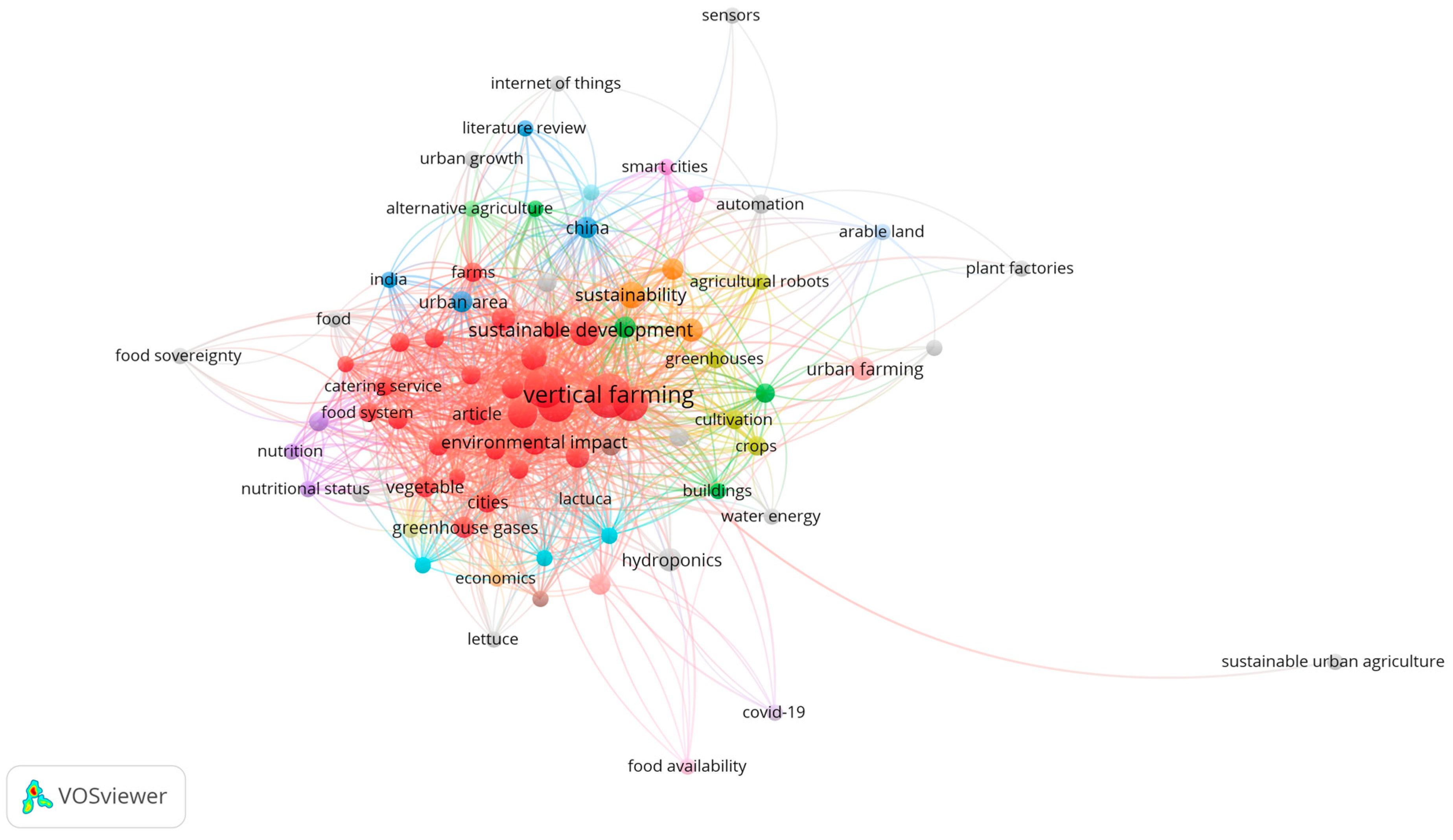
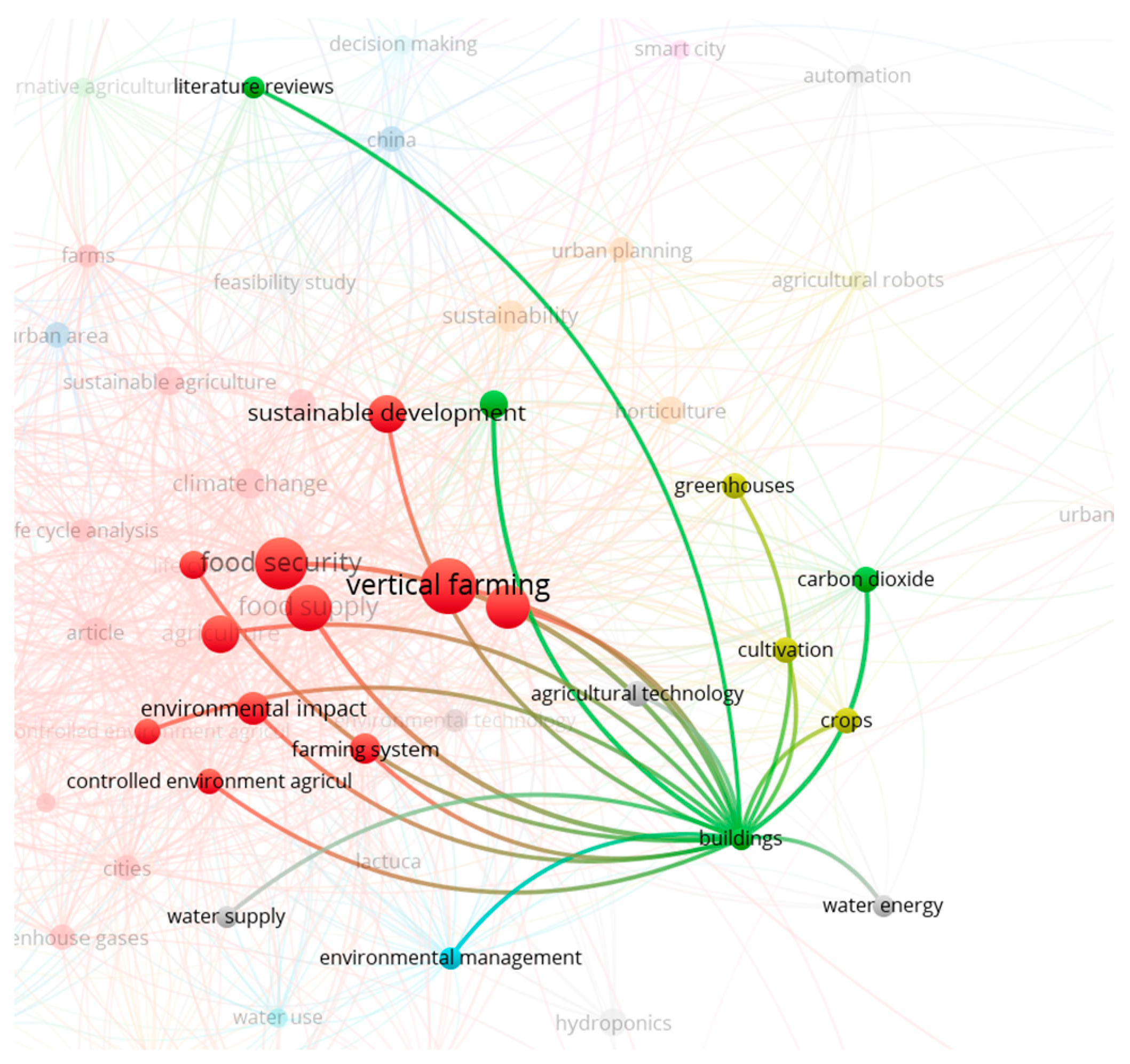

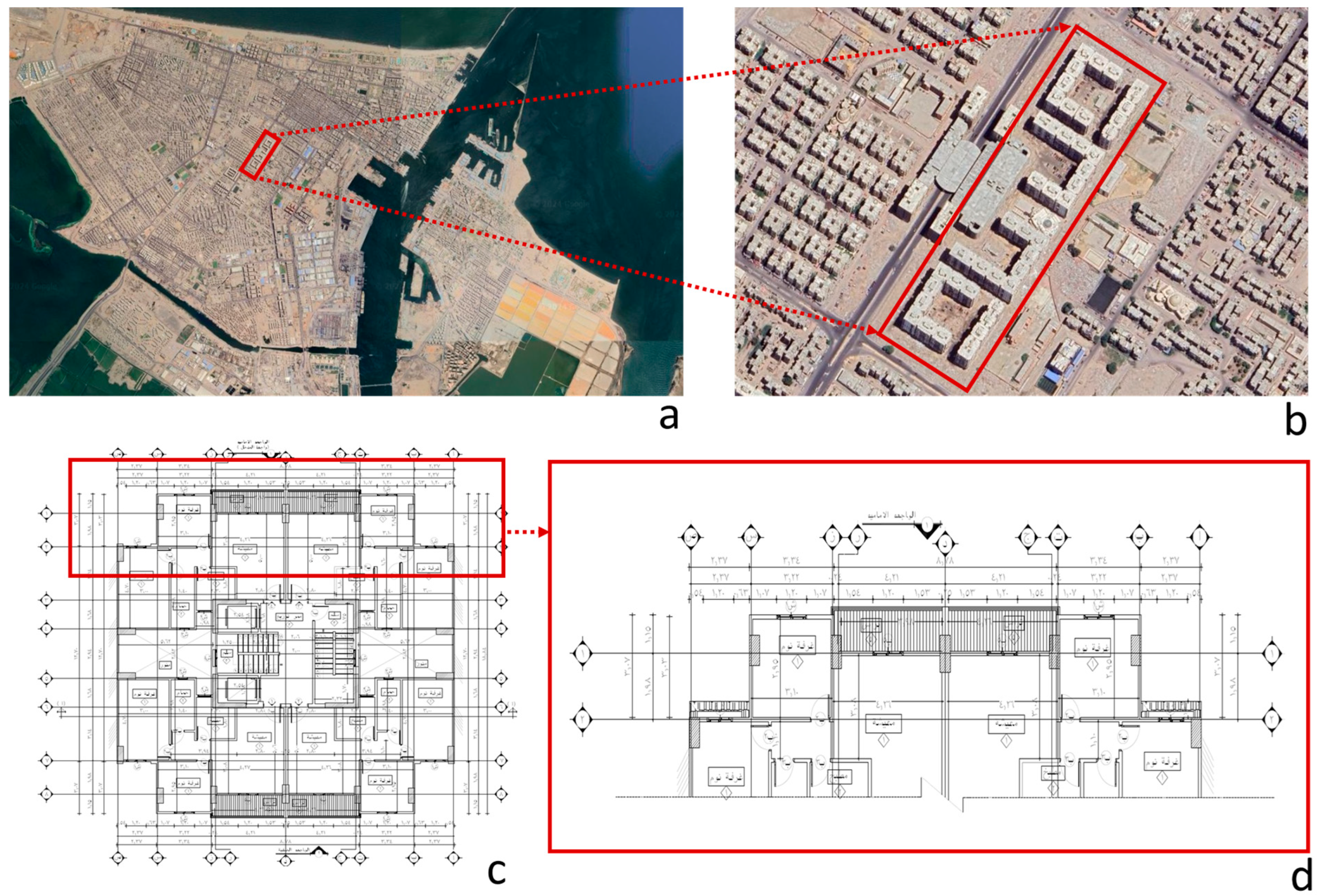






| 2D Green Surfaces | 3D Green Surfaces | ||||
|---|---|---|---|---|---|
| Description | A green wall is any plant-covered vertical surface, while a living wall is a green wall with a specially designed system with integrated irrigation and nutrients. | Three-dimensional green spaces can be designed with rich spatial variations, such as distributing multiple projecting green modules across the façade, integrating greenery into recessed balconies or openings to provide shaded green pockets, or integrating 3D green spaces across the entire façade. | |||
| Diagram | 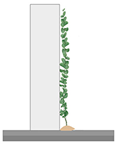 | 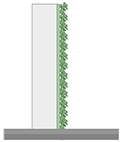 |  |  |  |
| Examples of buildings | [18] | [19] | [20] | [21] | [22] |
| Term | Green façade, green wall, vertical greenery system | Living wall, vertical greenery system | Vertical farming on facades, vertical garden, vertical landscaping, green pockets, garden terrace, vertical forest, elevated forest, sky farming | Vertical farming on facades, indoor sky garden, vertical landscaping, green pockets, sky/hanging garden, vertical forest, elevated forest, sky farming | Vertical farming on facades, vertical landscaping, green pockets, sky/hanging garden, vertical forest, elevated forest |
| Spatial configuration | Surfaces | Inside and on the surface of the buildings | Volumes | Volumes in the buildings | Volumes into building facades |
| Substrate depth | Less than 25 cm | Less than 25 cm | More than 25 cm | More than 25 cm | More than 25 cm |
| Plant types | Climbing plants | Grasses, small to medium shrubs, climbing plants | Trees, small to medium-large shrubs, climbing plants | Trees, small to medium-large shrubs, climbing plants | Trees, small to medium-large shrubs, climbing plants |
| Growing media | Soil | Soil or mix, water-hydroponics | Soil or mix, water-hydroponics, or aeroponics | Soil or mix, water-hydroponics, or aeroponics | Soil or mix, water-hydroponics, or aeroponics |
| Capacity to accommodate intensive vegetation | NA | NA | Applicable | Applicable | Applicable |
| Possibility of producing crops | Low capacity | Low–medium capacity | High capacity | High capacity | High capacity |
| Design Option#1 |
| The option idea is to integrate L-shaped planting trays into the terrace space so that the plants are exposed to sunlight and are easy to care for. |
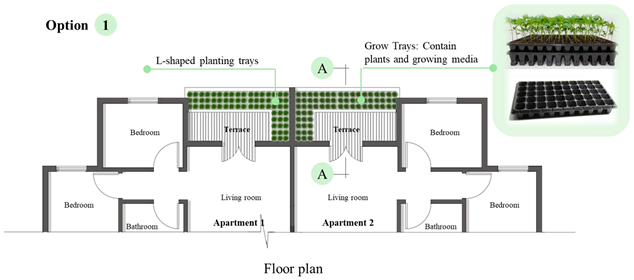 |
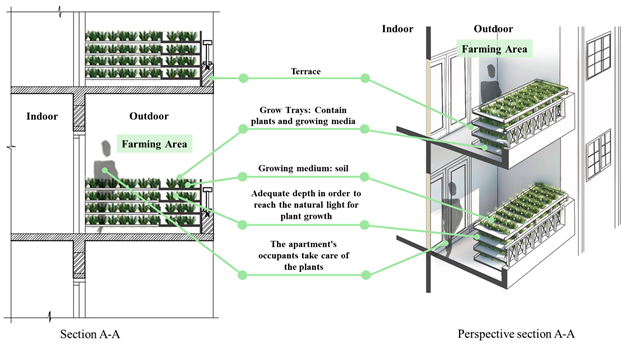 |
| Design Option#2 |
| The second option implies integrating planting trays on both sides of the terrace so that there is space to reach the terrace railing and also to take care of the plants. |
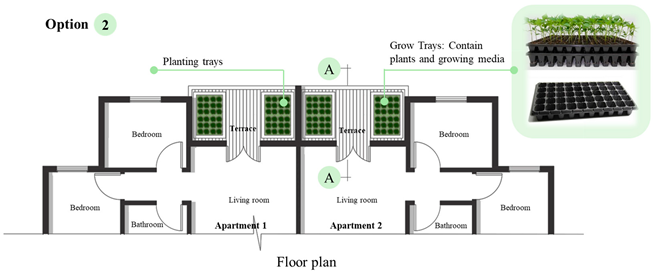 |
 |
| Design Option#3 |
| The third option idea is to integrate plant trays on the window façade, so that they are mounted on the wall below the window, and an opening is made in the wall to take care of the plants, and a window shutter is installed to close the opening. A steel cantilever beam is installed on the outer wall of the room, and a floor with channels is installed on the beams to pull the trays into the room. |
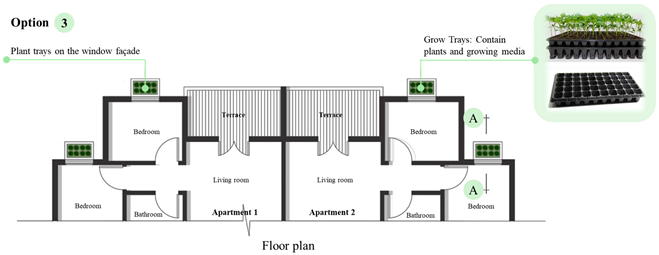 |
 |
| Population Size | Sample Size | |||
|---|---|---|---|---|
| Sample Table | ||||
| 95% Confidence Level | 99% Confidence Level | |||
| 5% Error | 1% Error | 5% Error | 1% Error | |
| 75 | 63 | 74 | 67 | 75 |
| 300 | 169 | 291 | 207 | 295 |
| 800 | 260 | 739 | 363 | 763 |
| 2500 | 333 | 1984 | 524 | 2173 |
| 25,000 | 378 | 6939 | 646 | 9972 |
| 100,000 | 383 | 8762 | 662 | 14,227 |
| 250,000 | 384 | 9248 | 662 | 15,555 |
| 500,000 | 384 | 9423 | 663 | 16,055 |
| 2,500,000 | 384 | 9423 | 663 | 16,478 |
| Q.# | Implications | Results Analysis |
|---|---|---|
| 03 | Motivation for integration | Most experts (62%) identified sustainability and environmental benefits as their primary motivation for integrating vertical farming into residential design projects. This dominant preference strongly reflects the growing emphasis on eco-friendly and climate-responsive architecture. |
| 04, 05 | Modifications and adjustments | Almost 75% of experts believe that vertical farming can be effectively integrated into existing residential balconies with only minor adjustments and modifications to the current architectural layout. |
| 06 | Biggest concern | Maintenance emerged as the most pressing concern, cited by 54% of the experts as the top challenge when adopting vertical farms in residential settings. |
| 07 | Structure challenges | Over half of the experts (56%) identified drainage and irrigation management as the most critical structural challenge when designing vertical farming systems. Other concerns, such as the system’s weight (16%), balcony layout (14%), and weather resistance (10%), were noted but considered less significant. |
| 08 | Construction barriers | High construction and installation costs (28%) and insulation requirements (26%) were highlighted as the most likely barriers to implementing vertical farming on balconies. |
| 09 | Maintenance challenges | The most expected maintenance challenge was regular irrigation, watering, and drainage, reported by 32% of experts. Resident involvement and knowledge followed at 22%, while concerns about system durability and pest control were each cited by 14%. |
| 10 | Design challenges | The most cited design challenge in incorporating vertical farming into residential balconies was the balcony’s façade relation (34%), followed closely by limited balcony area (30%) and unfavorable length-to-width proportions (24%). |
| 11 | Visual harmony | The most anticipated challenge in maintaining visual harmony when integrating vertical farming was the size and distribution of farming elements over the façade, cited by 44% of experts. This was followed by concerns about the proportion of the farming coverage area to the façade area (30%). |
| 12 | Environmental benefit | Improving air quality was identified by 32% of experts as the most effective environmental benefit of implementing vertical farming systems on balconies. This was followed by decreasing temperature (22%). |
| 13 | Building codes | Most experts (44%) believe that current building codes and regulations do not support the implementation of vertical farming on residential balconies, while 42% think the codes need to be updated, highlighting a clear need for regulatory revision to accommodate this emerging design trend. |
| 14 | Cost–benefit balance | Most experts (72%) indicated that the cost–benefit balance of vertical farming depends largely on how residents perceive and utilize it, whether as a personal use feature or a commercial investment. |
| 15 | Property value | Most experts (60%) believe that vertical farming could moderately increase property value in residential buildings due to its sustainability and self-sufficiency benefits. |
| Q.# | Implications | Results Analysis |
|---|---|---|
| 03, 04 | Awareness and interest | Slightly more respondents (72%) indicated prior awareness of vertical farming, reflecting a relatively high level of public familiarity with the concept. In parallel, 75% expressed strong interest in having a vertical farming system on their home balcony, with an additional 22% showing partial interest. Together, these findings demonstrate both awareness and a high degree of public receptiveness, suggesting strong potential for community acceptance and future adoption. |
| 05 | Most expected benefits | Users prioritized esthetic and green space value (29%), followed closely by environmental benefits (27%) and personal health and well-being (26%). Economic returns came last (16%), showing that residents are more driven by quality-of-life and environmental improvements than financial gains. |
| 06 | Plant preference diversity | Most respondents (60%) preferred a mix of all plant types, like edible crops, flowers, climbers, and medicinal or aromatic plants, when using a vertical farming system. This broad preference indicates a desire for multifunctional balcony gardens that combine beauty, utility, and wellness. |
| 07 | Cost vs. benefits | A combined 77% of respondents were open to growing food on their balconies as an economic option; 35% agreed outright, while 42% supported the idea if associated costs were low. This indicates potential public interest in the implementation of vertical farming with reasonable costs. |
| 08, 09, 10 | Health and esthetics | The responses reflect strong public belief in the multiple benefits of vertical farming. Most participants agreed that it can support organic food security (67%), enhance diet and health (66%), and serve as a healthier option to store-bought produce (66%). Additionally, 71% believed it would improve the visual appearance of their balconies. These results highlight a clear appreciation of vertical farming’s environmental, health, and esthetic value. |
| 11 | Concerns and challenges | Participants expressed a range of concerns about integrating vertical farming on balconies. The most cited worry was pest control and maintaining cleanliness (74%), followed by wind-related safety and structural stability issues (60%). Time and effort required for plant care (51%) and irrigation needs (46%) were also significant. These results highlight practical maintenance and environmental challenges as key user apprehensions. “Respondents were able to pick all that apply.” |
| 12 | Management preference | A total of 40% of respondents favored specialist maintenance (e.g., hiring a gardener). Meanwhile, 23% preferred individual personal systems over shared ones. These results suggest that ease and professionalism are key factors in user preference. |
| KPI Category | Example Indicator | Relevance to Survey Findings |
|---|---|---|
| Environmental |
| Users and experts emphasized VF’s environmental contribution, especially in reducing carbon footprint from food transport. |
| Maintenance challenges were a top concern; experts highlighted irrigation and drainage efficiency as critical issues. | |
| Both groups valued VF for improving microclimate and reducing heat gain, enhancing comfort in residential units. | |
| Economic |
| Cost was cited as a significant barrier; a KPI enables comparison of affordability across design options. |
| Concerns over long-term upkeep were frequently mentioned by stakeholders; this KPI helps assess operational feasibility. | |
| Experts and users acknowledged VF’s potential for economic return; this KPI captures the viability of such returns. |
Disclaimer/Publisher’s Note: The statements, opinions and data contained in all publications are solely those of the individual author(s) and contributor(s) and not of MDPI and/or the editor(s). MDPI and/or the editor(s) disclaim responsibility for any injury to people or property resulting from any ideas, methods, instructions or products referred to in the content. |
© 2025 by the authors. Licensee MDPI, Basel, Switzerland. This article is an open access article distributed under the terms and conditions of the Creative Commons Attribution (CC BY) license (https://creativecommons.org/licenses/by/4.0/).
Share and Cite
Waseef, A.A.E.; Shahda, M.; El Samaty, H.S.; Nosier, S. Integrating Vertical Farming into Residential Buildings in Egypt: A Stakeholder Perspectives-Based Approach. Buildings 2025, 15, 2917. https://doi.org/10.3390/buildings15162917
Waseef AAE, Shahda M, El Samaty HS, Nosier S. Integrating Vertical Farming into Residential Buildings in Egypt: A Stakeholder Perspectives-Based Approach. Buildings. 2025; 15(16):2917. https://doi.org/10.3390/buildings15162917
Chicago/Turabian StyleWaseef, Ahmed Abd Elaziz, Merhan Shahda, Hosam Salah El Samaty, and Shaimaa Nosier. 2025. "Integrating Vertical Farming into Residential Buildings in Egypt: A Stakeholder Perspectives-Based Approach" Buildings 15, no. 16: 2917. https://doi.org/10.3390/buildings15162917
APA StyleWaseef, A. A. E., Shahda, M., El Samaty, H. S., & Nosier, S. (2025). Integrating Vertical Farming into Residential Buildings in Egypt: A Stakeholder Perspectives-Based Approach. Buildings, 15(16), 2917. https://doi.org/10.3390/buildings15162917







